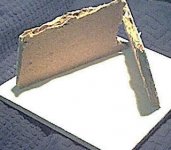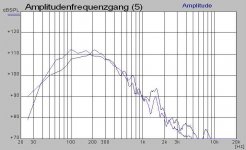I wanted to hear peoples opinions out there about which is better in a back-loaded folded horn: smooth curved bends vs angles corners.
For discussion sake, lets ignore how much more difficult smooth curves can be in the build process.
"better" in what respect?
I'd opine it depends on the overall design brief - i.e. whether you'd like to use numerous hard cornered folds as part of the HP filtering scheme, or want as much mid-range acoustic output from the mouth(s) as possible - at the expense of artifacts that Dave noted above.
Edit -Dave & Chris beat me to it.
Like most things in audio, there's no such thing as 'better' per se, it's entirely dependant upon the design goals. Smooth curves will provide higher efficiency across a wider BW. Conversely, sharp angles can be used (I use them in this way for e.g.) to assist as a low-pass function.
Like most things in audio, there's no such thing as 'better' per se, it's entirely dependant upon the design goals. Smooth curves will provide higher efficiency across a wider BW. Conversely, sharp angles can be used (I use them in this way for e.g.) to assist as a low-pass function.
Last edited:
smooth curved bends vs angles corners.
I take it you are asking about folded bass horns
apart from the good 'points' in the other posts
maybe you think of smooth round curves
versus 'just' placing a 45 degr plate in all corners
I doubt it makes much difference
at low frequncy, maybe even a 45degr bend have no or little advantage over 90 degr corners
your worst worries is the 'inner' side of a corner
with a bend going round a sharp corner, usually a baffle
to make a smooth rounding effective, the inner side should have a smooth rounded transistion a well
first and most you should look at volume transistion
but if bending around a sharp corner, it gets a bit unpredictive
and thus difficult to know exactly if it works the way its planned to
Eric1110
Hello i use softfiber for the presschamber and the
first meter of the horn,
i take 45° plate in the corner, specially at the beginn
of a horn the left 45° plate can be a large room
in comparison to the horn size a that point, this
would cause inner reflections with material sound of the horn
together the sound will get colourated.
softfibre + Hornmouth measurements Kornett
Hello i use softfiber for the presschamber and the
first meter of the horn,
i take 45° plate in the corner, specially at the beginn
of a horn the left 45° plate can be a large room
in comparison to the horn size a that point, this
would cause inner reflections with material sound of the horn
together the sound will get colourated.
softfibre + Hornmouth measurements Kornett
Attachments
Thankyou all for the great replies. In fact I'm planning on a BLH for a pair of Coral Beta 8a (the 16w ones). I know about the traditional Coral horn the was designed for the Beta 8 but I was thinking of experimenting a bit with the design.
I understand every design choice in audio is a trade off of one kind for another. I promise I'll try never to say better again.
I do remember reading the concept of using sharp angle for low pass... I just can't remember where. Wish I could.
I understand every design choice in audio is a trade off of one kind for another. I promise I'll try never to say better again.
I do remember reading the concept of using sharp angle for low pass... I just can't remember where. Wish I could.
In fact I'm planning on a BLH for a pair of Coral Beta 8a (the 16w ones).
not an easy job to get bass out of Beta8
but ought to be possible
What about them?
Ron's preference is for maximum energy preservation, so he avoids very sharp angles. I don't know if the C horns have a high reputation so your guess is as good as mine on that score.
As has been stated, there is no real answer to the original question. What is used is entirely dependant upon the design goals.
Ron's preference is for maximum energy preservation, so he avoids very sharp angles. I don't know if the C horns have a high reputation so your guess is as good as mine on that score.
As has been stated, there is no real answer to the original question. What is used is entirely dependant upon the design goals.
Last edited:
Regarding Ron Clarke's (family of ) horns - unlike Scott's designs, I've only built/heard one of Rons - the Austin for FE126.
For those interested in theories of operation, others here can explain in engineering terms, but all that I needed to understand was revealed in the listening. These are a great sounding speaker - my domestic situation simply precludes any of the larger horn enclosures (front or rear mouthed), or for that matter conventional bipoles, OBs etc.
For those interested in theories of operation, others here can explain in engineering terms, but all that I needed to understand was revealed in the listening. These are a great sounding speaker - my domestic situation simply precludes any of the larger horn enclosures (front or rear mouthed), or for that matter conventional bipoles, OBs etc.
I don't know if the C horns have a high reputation
The plans for the C Horn have never been released (so no builds independent of the designers). The only reputation is largely that some people really like what i think are its garish looks. The only comments on sonics i've seen are by the maker.
dave
Bending of pipes is tricky. If we imagine a 100 Hz (positive) pressure wave is migrating down a tube the distance from the start to the crest (pressure maxima) is 0.85m. Such a pressure zone will pressurize quite large bends and go uninpeded around the bends. At 500 Hz the distance is ony 0.17m and then it is quite comparable in size i with many bends. So what is good in a subwoofer horn below 80 Hz may not work in a horn that is used up to 200-500 Hz.
If we look at BLHs like the Jericho and use 90 degree bends as units ( one 180 degree = two 90 degree) it has five 90 degree bends and some TLS like the Atkins mini has no less than ten 90 degree bends. The textbooks tells us that as long as the soundwave is much longer than the radius of the bend losses are negligible. OK then how big is "much" and little is "negligible"?? If the complicated pipe is used to increase radiation resistance for the driver losing 0.5 dB in a bend might be classified as "negligible" but if you have 5 or 10 of those bends and lose 2.5 or 5 dB it is anyting but "negligible".
So I try to always use corner reflectors and rounded inner corners. The reflectors will work as braces and should not be harmful in any setting allmost. If it bend radial reflectors, 45 degree radial reflectors or Heugen reflectors should matter less.
If we look at BLHs like the Jericho and use 90 degree bends as units ( one 180 degree = two 90 degree) it has five 90 degree bends and some TLS like the Atkins mini has no less than ten 90 degree bends. The textbooks tells us that as long as the soundwave is much longer than the radius of the bend losses are negligible. OK then how big is "much" and little is "negligible"?? If the complicated pipe is used to increase radiation resistance for the driver losing 0.5 dB in a bend might be classified as "negligible" but if you have 5 or 10 of those bends and lose 2.5 or 5 dB it is anyting but "negligible".
So I try to always use corner reflectors and rounded inner corners. The reflectors will work as braces and should not be harmful in any setting allmost. If it bend radial reflectors, 45 degree radial reflectors or Heugen reflectors should matter less.
Bending of pipes is tricky. If we imagine a 100 Hz (positive) pressure wave is migrating down a tube the distance from the start to the crest (pressure maxima) is 0.85m. Such a pressure zone will pressurize quite large bends and go uninpeded around the bends. At 500 Hz the distance is ony 0.17m and then it is quite comparable in size i with many bends. So what is good in a subwoofer horn below 80 Hz may not work in a horn that is used up to 200-500 Hz.
If we look at BLHs like the Jericho and use 90 degree bends as units ( one 180 degree = two 90 degree) it has five 90 degree bends and some TLS like the Atkins mini has no less than ten 90 degree bends. The textbooks tells us that as long as the soundwave is much longer than the radius of the bend losses are negligible. OK then how big is "much" and little is "negligible"?? If the complicated pipe is used to increase radiation resistance for the driver losing 0.5 dB in a bend might be classified as "negligible" but if you have 5 or 10 of those bends and lose 2.5 or 5 dB it is anyting but "negligible".
So I try to always use corner reflectors and rounded inner corners. The reflectors will work as braces and should not be harmful in any setting allmost. If it bend radial reflectors, 45 degree radial reflectors or Heugen reflectors should matter less.
Yeah, Bruce Edgar talked about this in his Show Horn article. If you want the higher frequencies out of a folded horn, then the 45 degree reflectors are required.
- Status
- This old topic is closed. If you want to reopen this topic, contact a moderator using the "Report Post" button.
- Home
- Loudspeakers
- Full Range
- Folded Horns: Smooth curves vs angled corners

